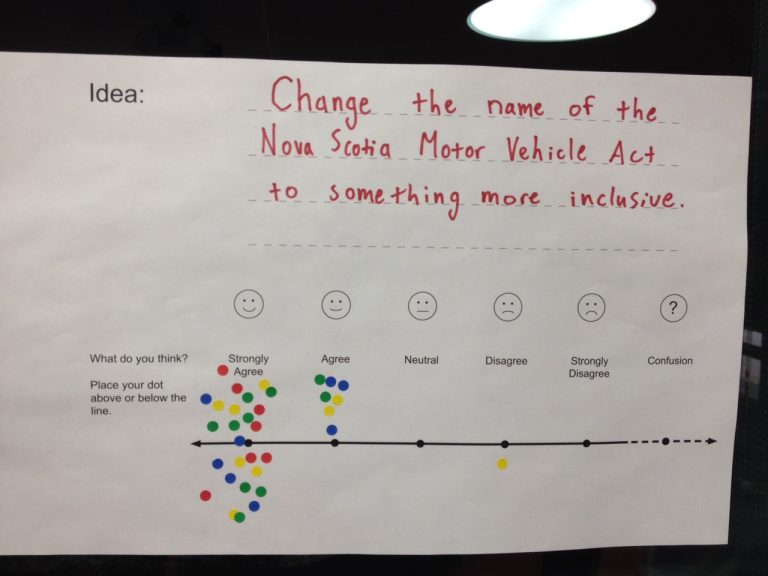Motor Vehicle Act to Traffic Safety Act: Background Information
The Halifax Cycling Coalition has been pushing the Provincial Government to reform the Nova Scotia Motor Vehicle Act (MVA) along with our partners Bicycle Nova Scotia, the Ecology Action Centre, the Atlantic Active Alliance, and Walk N’ Roll Halifax. Our objectives are as follows:
- Increase road safety for all, while eliminating traffic fatalities and serious injuries
- Promote and prioritize walking and wheeling
- Remove barriers to walking and wheeling, including legal penalties
- Increase the responsibility of drivers based on the potential damage and loss of life they could cause
- Expand tools available to create safe, continuous and connected active transportation networks
Nova Scotia’s Motor Vehicle Act was last re-written in the 1920’s, and there were many changes to various sections since then. This resulted in a confusing piece of legislation that did not provide protection for vulnerable road users (ie: non-motorized road users, such as people walking, cycling, and rolling). In 2018 the Nova Scotia Department of Transportation and Infrastructure Renewal began work on updating the MVA, now called the Traffic Safety Act (TSA). The new Traffic Safety Act has been fully re-written. The Act itself is a framework piece of legislation. The details will be found in the regulations connected to the TSA. The regulations are easier to change than the Act itself, making the laws more adaptable to new technologies and the changing needs of road users. Adaptability is important because the way that people travel is adapting all the time.
We have been actively working on reforming the Motor Vehicle Act since 2016. You will find a timeline of the process with more details below. Read on to learn where we are currently in the process.

2016 Public Engagement
We co-hosted a community engagement session in January 2016. At the engagement session, we asked for the public’s input about changing the MVA to make it safer for people walking and wheeling (wheeling = cycling, skateboarding, using a wheelchair, using a mobility device, rollerblading, etc). There were 80 participants who came to the in-person event, and another 148 participants in our online survey. After gathering public feedback and doing our own policy research and analysis, we came up with a list of recommendations, which we shared with the provincial Department of Transportation and Infrastructure Renewal.

At the 2016 Engagement Session, we did a Dot-mocracy Activity.
The community’s top priorities from the session included: prohibit the right hook (the right hook is when a person cycling is going straight on the right side of a vehicle and a person driving turns right and hits the person cycling), prohibit dooring (dooring is when someone opens a car door into the path of a person riding a bike), allow bikes to ride through a crosswalk, passing on the right clarification, and allow a municipality to post speed limits below 50km/hour.
The coalition of groups followed up by presenting all 37 of the community recommendations to the province’s Road Safety Advisory Committee and the Deputy Minister of Transportation and Infrastructure Renewal.
Thanks to the support of our members, we were able to work on a formal process of realizing these important policy changes. Our committee drafted a policy for the following MVA amendments based on the 2016 engagement session:
- Prohibit dooring
- Prohibit the “right-hook”
- Prohibit “left-cross”
- Clarify passing a cyclist safely
- Cross-rides
- Change the name of the Motor Vehicle Act
- Recognize and define “vulnerable road users”
Addressing the systemic problems in the MVA can be a tedious process, but long-term will have a big impact on making the roads safer for people who cycle and shifting the culture of how we use streets.
Department of Transportation and Infrastructure Renewal Response
In December 2020 the Halifax Cycling Coalition, along with our partners Bicycle Nova Scotia, the Ecology Action Centre, the Atlantic Active Alliance, and Walk N’ Roll Halifax hosted two public engagement sessions to gather feedback about the TSA regulations that pertain to rules of the road. Several of our recommendations have been addressed in the new TSA regulations, several have not, and there are some things we still have questions about. You can read the draft Rules of the Road Regulations here. Please see below for an overview of what’s been included, what hasn’t, and what we are asking the Department of Transportation and Infrastructure Renewal for more information about.
Included
- Changed name to Traffic Safety Act
- Bicycle signals/traffic lights permitted [53]
- “Dooring” prohibited [103]
- Allowance for permanently attached bicycle seats [119(1)(a)]
- Municipal ability to designate shared-use sidewalks [117(3)]
- More info about the use of bicycle lights
- Clarity around cycling through roundabout [121]
- Signalling turns
- No longer obligated to signal for the duration of turn [29(3)(a)]
- Can now use the right arm to signal a right turn [29(4)]
- Not required to hand signal if unsafe to do so [29(5)(b)]
Not Included
- Passing distance not increased to 1.5m on roads 70km/h or more [30(7)(b)]
- Cyclists not permitted to treat a stop sign as a yield
- No allowance for municipalities to decrease default of 50km/h speed limit [59]
- Cyclists still required to dismount at crosswalks
- Seeking further clarity on cross-rides
- Riding two-abreast not permitted [122(1)]
- Cyclists passing vehicles on the right still not clear
- Parking distance from crosswalk still 5m, not 10m [135(1)(c)]
- Right hook not clarified
- 30km/h school zone limit only applies when a child is present [61(3)]
- Construction vehicles can drive in bicycle lanes [19(1)(c)]
- Drivers allowed to drive in a bicycle lane if the vehicle in front is waiting to make left turn [19(2)(a)]
- Pedestrians crossing at any point other than crosswalk must yield to traffic [20(5)]
- Seizure of vehicle or conveyance still permitted as an enforcement tool under Bill 80 [62]
- Religious exemption for helmets requires a certificate from Registrar [111(2)]
- Must yield to traffic when merging from a bicycle lane [13(3)] and cyclists must yield to other traffic in the area they are entering [114(4)]
- Cyclist required to ride in a bicycle lane when one is present [114(1)]
- Understanding pedestrians (including people using a wheelchair) required to use the sidewalk if present
- How does flag requirement for seated riders shorter than 1m impact children [118(3)]
- Cyclists must leave 1m of space when passing a vehicle on the left [112(3)]
- Only e-bicycle (power-assisted bicycle) mention is about the minimum age of 14 years for operators [123]
- Bicycles not recognized as mobility aids
We are working to summarize participant feedback from the public engagement sessions we held in December 2020. With our partners, we will then develop written feedback for the Nova Scotia Department of Infrastructure Renewal about the Using the Road Regulations. We encourage you to submit your own feedback to the province about the TSA Rules of the Road to [email protected]. Please cc us ([email protected]) on your e-mails so we can keep track of feedback being submitted. You can also cc your local MLA to let them know your concerns. You can look up your MLA and their contact information on the Province’s website.
The deadline to submit feedback has been extended to Friday, January 22, 2021.
Public support helps these amendments become enacted. Please take a moment to submit your feedback.





